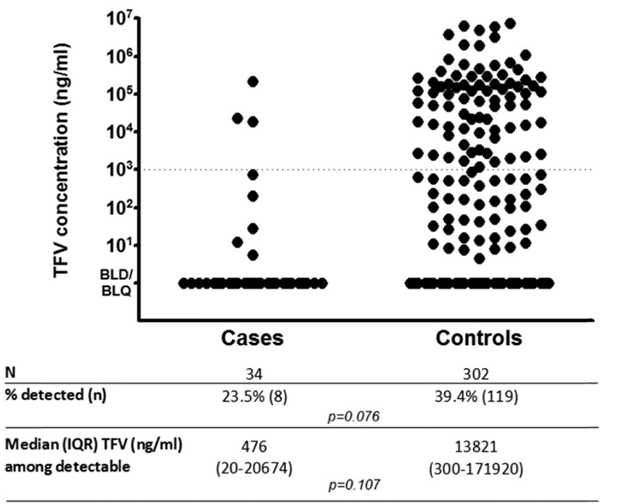Genital tenofovir concentrations correlate with protection against HIV infection
Data from the CAPRISA 004 trial provides further insights into a potential correlate of protection against HIV infection.
This case control study, which was published this week in the Journal of AIDS, showed that a tenofovir concentration of >=100 ng/mL in cervicovaginal fluid (CVF) was associated with 65% (95% CI: 6% to 87%) protection against HIV, whereas a >=1000 ng/mL concentration correlated with 76% (95% CI: 8% to 92%) protection against HIV infection.
The CAPRISA 004 trial showed that coitally dosed tenofovir 1% gel reduced HIV acquisition by 39% overall and 54% when used consistently. The objective of this analysis was to ascertain its pharmacokinetic–pharmacodynamic relationship to protect against HIV acquisition.
Genital and systemic tenofovir concentrations in 34 women who acquired HIV (cases) were compared with 302 randomly selected women who remained HIV uninfected (controls) during the CAPRISA 004 trial. In total, 336 CVF, 55 plasma, and 23 paired cervical and vaginal tissue samples were assayed by validated methods for tenofovir and tenofovir diphosphate (tenofovir-DP) detection.

Tenofovir was detected in the genital tract in 8 (23.5%) cases and 119 (39.4%) controls (P = 0.076). Among those with detectable genital tract tenofovir, the median CVF concentrations were 97% lower in cases compared with controls, 476 versus 13,821 ng/mL (P = 0.107). A total of 14.7% (5/34) of cases and 32.8% (99/302) of controls were found to have tenofovir CVF concentrations above 100 ng/mL [odds ratio (OR): 0.35, P = 0.037] (Figure). At a higher threshold, 8.8% (3/34) of cases and 26.2% (79/302) of controls were found to have tenofovir CVF concentrations above 1000 ng/mL (OR: 0.27, P = 0.036). Plasma tenofovir concentrations were ,1 ng/mL in all women and were detected only in controls (16.7%) and not in cases (0%), (P = 0.031). Returned used tenofovir gel applicators and CVF concentrations were correlated (Spearman r = 0.22, P = 0.001).
Based on this analysis, the attainment of this concentration during sexual exposure consistently may be necessary to achieve high levels of protection against HIV.
For further reading see: Kashuba et al. http://journals.lww.com/jaids/Abstract/2015/07010/Genial_Tenofovir_ Concentrations_Correlate _With.2.aspx
